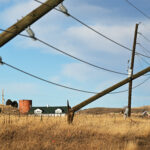Colorado highway planners are experimenting with the same technology used by some prisons for perimeter security to prevent drivers from colliding with deer and elk.
The Colorado Department of Transportation launched a new wildlife detection system Tuesday along a stretch of U.S. 160 east of Durango in southwestern Colorado, where officials say about 70 percent of all reported collisions involve wild animals.
Fencing was deemed unworkable, and wildlife detection systems that use lasers or microwaves were ruled out since they could be triggered by snow or tree branches.
Instead, highway officials are testing a system that involves a cable buried parallel to the highway. The cable emits an electromagnetic field that is calibrated to detect large animals.
When an animal is detected, electronic signs are activated to warn drivers.
To prevent cars from triggering the signs when they enter U.S. 50, separate sensors were installed to detect vehicles and send a signal that would keep the warning signs dark.
The pilot project includes seven speed radar detectors to register traffic counts and track drivers’ speed outside and inside the test zone.
“The variable we’re looking for is motorist behavior,” CDOT environmental specialist Tony Cady said. “To test the validity of this system, we need to determine if there’s a drop in speed and also whether this is a long-term behavior change, or just something motorists stop reacting to after a period of months.”
CDOT spokeswoman Nancy Shanks said the department would need to study results for about three to five years to see whether drivers slow down when the warning signs are activated.
Costs of the pilot program are estimated at $1 million. Shanks said the detection system could cost less elsewhere, since the pilot program’s price includes research expenses.
Was this article valuable?
Here are more articles you may enjoy.

 Marijuana’s Move to Schedule III: What it Really Means for Cannabis Insurance
Marijuana’s Move to Schedule III: What it Really Means for Cannabis Insurance  NYT Asks Judge to Dismiss Trump’s ‘Implausible’ Defamation Suit
NYT Asks Judge to Dismiss Trump’s ‘Implausible’ Defamation Suit  Waymo to Update Software Across Fleet After Major Power Failure
Waymo to Update Software Across Fleet After Major Power Failure  Rare Weather Warning Issued as Strong Gusts Fuel Colorado Wildfire Threats
Rare Weather Warning Issued as Strong Gusts Fuel Colorado Wildfire Threats 